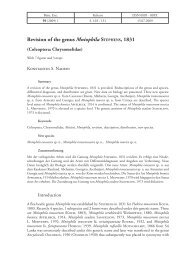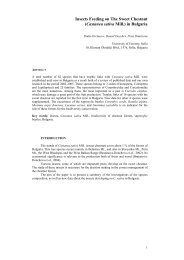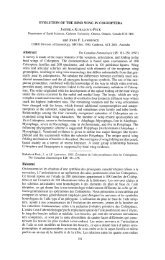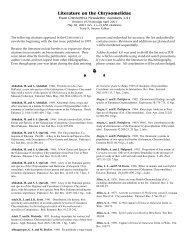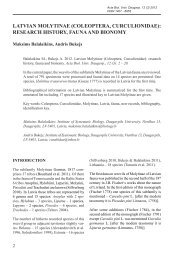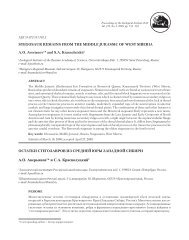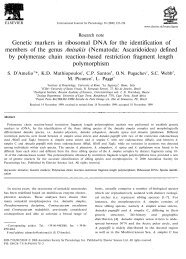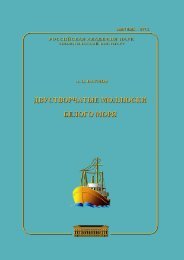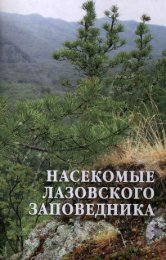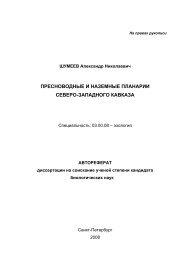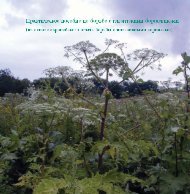You also want an ePaper? Increase the reach of your titles
YUMPU automatically turns print PDFs into web optimized ePapers that Google loves.
142A.L. OZEROV & M.G. KRIVOSHEINA. TYPES OF SCATHOPHAGIDAEThe famous German dipterologist TheodorBecker (1840–1928) described several newspecies of Scathophagidae from northernRussia in 1897–1914. We examined thetypes of eleven Scathophagidae speciesdescribed by Becker, which were found inZIN.The type specimens described byPortschinsky, Stackelberg and Becker werelabelled properly; hence we recognizedthem without difficulties. A part of typesof the species described by Gorodkov wereproperly labelled as well. At the same time,the new species described and the lectotypesdesignated by him in 1974 (Gorodkov,1974) were lacking the respectivelabels. Luckily, all of these specimens werefound in a separate drawer. The first authorlabelled as the holotypes of Cordilura sagittiferaGorodkov, 1974 and C. zaitzevi Gorodkov,1974 the only male specimen in eachtype series with the label consistent withthat of the holotype (Gorodkov, 1974) andwith the apex of abdomen cut and placed ina vial with glycerol. Apparently, Gorodkov(1974) illustrated the male genitalia fromthese specimens.All taxa are listed in alphabetic order oftheir species names. The labels are separatedfrom each other by oblique stroke. The labeldata are put in quotation marks, with translationand comments given in brackets.The terminology follows McAlpine(1981) and Cumming et al. (2009). The followingabbreviations are used: a, anterior; d,dorsal; p, posterior; v, ventral; combinationsof these four abbreviations, all used for legchaetotaxy; ALO, A.L. Ozerov.ANNOTATED LIST OF TYPESOrder DIPTERAFamily SCATHOPHAGIDAEalbidohirta Becker, 1907b: 254 (Scatophaga).Type locality: “Kurlyk” [Lake HurlegHu, 37.28°N 96.89°E] (China).Lectotype. Male: “Kurlyk, Baingol vost.Tsaydam. RobKozlov 21.V.95” [Kurlyk, easternBaingol, Caidam, 21.V.1895, coll. Roborowskyet Kozlov; in Russian] (designated by Ozerov &Krivosheina, 2011: 105).Paralectotypes. One male, labelled same aslectotype. Five females: (1) “r Orogyn Syrtynyu Nan’shan, Gobi, RobKozlov 3–20.V.95” [inRussian], (2) “oz. Iche – r. Orogyn s. Tsaydamts. Gobi RobKozlov 3 VII 95” [in Russian], (3)“r Orogyn Syrtyn yu Nan’shan, Gobi, RobKozlov3–20 VII 95” [in Russian], (4) “Kara Tyube,na zap ot Khami, Gobi. RobKozlov 5.IX.95” [inRussian], (5) “r. Bomyn (Ichegan) sv. TsaydamGobi RobKozlov VI 95” [in Russian].Notes. The species was described fromeight specimens collected in China; sevenof them, two males and five females, arekept in ZIN. The eighth specimen, male, isin Museum für Naturkunde der Humboldt-Universität, Berlin (Ozerov & Krivosheina,2011: 106).The lectotype is pinned; one of middlelegs is glued to the geographical label andlacking tarsomeres 2–4, the other middleleg is broken, tibia and tarsi of the left hindleg are broken, as well as tarsomeres 2–4 ofthe right hind leg; the abdomen is cut andplaced in a vial with glycerol mounted onthe same pin with the specimen.The male paralectotype in ZIN isScathophaga mihalyii (Šifner, 1975). Themale paralectotype in Berlin (with labels:“oz. Iche – r. Orogyn s. Tsaydam ts. GobiRobKozlov 3 VII 95” [in Russian] / “Gobi.Asien 51896. VII”/ “albidihirta Beck.”/“ZMU Berl”/ “Scatophaga albidohirta Beck.SYNTYPE labelled 1954 by J.R. Vockeroth”)is conspecific with the lectotype.This specimen was examined by ALO in2012 and labelled as a paralectotype.Three female paralectotypes (labels1–3) are conspecific with the lectotype.Two female paralectotypes (labels 4–5)are Scathophaga species, but surely are notS. albidohirta.Identity. A good species of the genusScathophaga Meigen, 1803. It was redescribedand illustrated by Ozerov & Krivosheina(2011).© 2013 Zoological Institute, Russian Academy of Scienсes, Zoosystematica Rossica 22(1): 141–149
A.L. OZEROV & M.G. KRIVOSHEINA. TYPES OF SCATHOPHAGIDAE 143amplipennis Portschinsky, 1887: 199(Scatophaga).Type locality: “[high in the upper reachesof Yellow [=Hawang] River in northeasternTibet]” (China).Lectotype. Male: “Scatophaga amplipennis”[handwritten by Portschinsky] (designated byGorodkov, 1967: 446).Paralectotype. Male, labelled same as lectotype.Notes. The species was described fromboth sexes. Only two males were found inZIN, both without geographical labels. Thelectotype (designated by Gorodkov (1967),but labelled by ALO) is pinned, in very goodcondition. The second male was labelled byALO as a paralectotype.This species was transferred to the genusScatomyza Fallén, 1810 (Ozerov & Krivosheina,2011).Identity. Similar to Scatomyza magnipennis(Portschinsky, 1887) (see below),probably is a junior synonym of this species.arctica Becker, 1897: 398 (Scatophaga).Type locality: Malye Karmakuly, NovayaZemlya (Russia).Lectotype. Male: “Mal. Karmakuly, NovayaZemlya. 31.VII.[18]96 Jacobson” [in Russian] /“Scatophaga arctica Bec[ker]” [handwritten byT. Becker] / “Scatophaga apicalis Curtis maleGorodkov det. [19]73” (designated here).Paralectotype. Female: “stoyanka u g. Chernyshova,Nov. Zem. 4.VIII.96 Jacobson” [in Russian].Notes. The species was described fromthe specimens of both sexes collected in NovayaZemlya. There are two specimens inZIN, male and female. The male is in verygood condition; its abdomen is dissectedand placed in a vial with glycerol on thesame pin with the specimen. This specimenhas been labelled by ALO and is designatedhere as a lectotype of Scatophaga arctica.The lectotype is conspecific with Scathophagamultisetosa (Holmgren, 1883).The female has been labelled by ALO asa paralectotype.One male paralectotype (with labels:“Novaja Semlja mons Tschernyschew G.Jacobson 5.VIII.96”/ “arctica Becker”/“41956”/ “Scatophaga arctica Beck. SYN-TYPE labelled 1954 by J.R.Vockeroth”/“Scatophaga apicalis Curt. Det. 1962J.R. Vockeroth”) is kept in Museum fürNaturkunde der Humboldt-Universität,Berlin. This specimen was examined byALO in 2012 and labelled as a paralectotype;it is conspecific with Scathophagamultisetosa (Holmgren, 1883).Identity. Scathophaga arctica syn. nov.is a junior synonym of S. multisetosa (Holmgren,1883).infumatum Becker, 1907b: 256 (Coniosternum).Type locality: “Sogon-gomba” [upperreaches of the Yangtze River, ca. 33.6°N96.4°E] (China).Holotype. Male: “Sogon-gomba – r Ichu, verGoluboy, Kozlov, kon VII.[19]00” [in Russian]/“Tibet, Kozl. VII.00”/ “infumatum Beck.”/ “5”[three labels handwritten by T. Becker].Notes. The species was described from asingle male. The holotype is pinned, in verygood condition; left wing is partially torn;the abdomen is cut and placed in a vial withglycerol on the same pin with the specimen.Identity. A good species of Scathophaga.It was redescribed and illustrated by Ozerov& Krivosheina (2011).fulvisetis Becker, 1915: 64 (Pleurochaeta).Type locality: “aus dem Polaren Ural”(Russia).Holotype. Male: dark gold circle/ “PopyzrnyUral, s. Tobol’s. gub. FZaitzev 6 VII [18]09” [inRussian] / “det. Becker” [printed] “Pleurochaetafulvisetis B.” [handwritten by T. Becker].Notes. The species was described from asingle male. The holotype is pinned, in excellentcondition.Identity. A junior synonym of Pleurochaetellasimplicipes (Becker, 1900).longinqua Becker, 1915: 66 (Scopeuma).Type locality: “Tundra des Fl. Kara”[tundra in environs of the Kara River, theborder of Nenetskii Autonomous Districtand Tyumen Province] (Russia).Lectotype. Male: “Karskaya tundra s. Tobol’s.gub. FZaitzev 12 VII [19]09” [in Russian] (designatedhere).© 2013 Zoological Institute, Russian Academy of Scienсes, Zoosystematica Rossica 22(1): 141–149
144A.L. OZEROV & M.G. KRIVOSHEINA. TYPES OF SCATHOPHAGIDAEParalectotypes. Two females: (1) dark goldcircle/ “Karskaya tundra s. Tobol’s. gub. FZaitsev12 VII 09” [in Russian]/ “det. Becker”[printed] “Scatophaga longinqua B” [handwrittenby T. Becker], (2) “Karskaya tundra s. Tobol’s.gub. FZaitsev 12 VII 09” [in Russian].Notes. The species was described fromthree specimens of both sexes. All are inZIN, a male and two females. The male hasbeen labelled by ALO and is designatedhere as a lectotype. The lectotype is pinned,in good condition; the abdomen is dissectedand placed in a vial with glycerol on thesame pin. The two females were labelled byALO as paralectotypes. All three type specimensare Scathophaga cordylurina (Holmgren,1883).Identity. A junior synonym of Scathophagacordylurina (Holmgren, 1883).magnipennis Portschinsky, 1887: 198(Scathophaga).Type locality: “San Kul’” [Sonkol Lake,3160 m] (Kyrgyzstan).Lectotype. Male: “San Kul’” [in Russian]/“Scatophaga magnipennis” [handwritten byPortschinsky] (designated by Gorodkov, 1967:445).Paralectotype. Female, labelled same as lectotype.Notes. The species was described fromboth sexes. Two specimens, male and female,are kept in ZIN. The male lectotype (designatedby Gorodkov (1967), but labelledby ALO) and the female paralectotype arepinned, in very good condition. The femalewas labelled by ALO as a paralectotype.Identity. A good species of the genusScatomyza.nudiseta Becker, 1907a: 4 (Ceratinostoma).Type locality: “Neu-Sibirische Inseln, InselKotelnyi, Südufer beim Stan-Michailow”and “West-Taimyr-Halbinsel, Walter-Bai,Ostufer am Cap Kriwoj” (Russia).Syntypes. One male: “Taimyr occ. Birulja22 VII– 4 VIII 901”/ “mukhi poym. bl. palatki(stoyanka XI)” [in Russian]/ “Polyarnayaekspeditsiya” [in Russian]/ “det.Becker” [printed] “Ceratinostoma nudisetaBeck.” [handwritten by T. Becker]. Onefemale: “Ins. Kotelnyi A. Wolossowitch 10–25 VI. 1901”/ “Polyarnaya ekspeditsiya”[in Russian]/ “det. Becker” [printed] “Ceratinostomanudiseta Beck.” [handwrittenby T. Becker].Notes. This species was described fromthree exemplars of both sexes; two syntypes,male and female, were found in ZIN.In the male, the left postpedicel, tarsi ofright fore leg, tibia and tarsi of left mid leg,right mid leg and both hind legs are broken,otherwise in good condition. The female isin good condition.Identity. Both syntypes are not Scathophagidaebut Muscidae probab ly belongingto Spilogona Schnabl, 1911 (A.C. Pont,pers. comm.).obscuripes Becker, 1915: 64 (Acerocnema).Type locality: “Tundra des Fl. Kara”[tundra in environs of the Kara River, theborder of Nenetskii Autonomous Districtand Tyumen Province] (Russia).Holotype. Male: dark gold circle/ “Karskayatundra s. Tobol’s. gub. FZaitzev 12 VII [19]09”[in Russian]/ “det. Becker” [printed] “Acerocnemaobscuripes B.” [handwritten by T. Becker].Notes. The species was described froma single male. The holotype is pinned, invery good condition. It belongs to the genusNanna Strobl, 1894, not to AcerocnemaBecker, 1894, and was repeatedly describedby Engelmark (1999) as Nanna indotatum.Identity. Nanna obscuripes (Becker,1915), comb. nov., with a junior synonymN. indotatum Engelmark, 1999, syn. nov.orbitalis Becker, 1915: 65 (Scopeuma).Type locality: “Pe-mal” [hilly area betweenthe northernmost parts of the PolarUrals and the Arctic sea coast] (Russia).Holotype. Female: “Pe-Mal, s. Tobol’s. gub.FZaitzev 15 VII [19]09” [in Russian]/ “det.Becker” [printed] “Scatophaga orbitalis B.”[handwritten by T. Becker].Notes. The species was described froma single female. The holotype is pinned, invery good condition. It is conspecific withScathophaga nigripalpis (Becker, 1907)© 2013 Zoological Institute, Russian Academy of Scienсes, Zoosystematica Rossica 22(1): 141–149
A.L. OZEROV & M.G. KRIVOSHEINA. TYPES OF SCATHOPHAGIDAE 145and was correctly recognized by Gorodkov(1986: 33).Identity. A junior synonym of Scathophaganigripalpis (Becker, 1907).paradoxopyga Stackelberg, 1952: 405(Acerocnema).Type locality: Matochkin Shar (73.3877°N, 55.2144°E), Novaya Zemlya (Russia).Holotype. Male: “Nov. Zemlya, MatochkinShar xxx Vakulenko 11/VII.925” [in Russian;xxx = illegible]/ “Stackelberg det.” [printed]“Acerocnema paradoxopyga sp.n. Typ. 41” [handwrittenby A. Stackelberg].Paratype. Male: “O-v Vrangelya. AternonRodzhers 27.VI.939 Portenko” [in Russian].Notes. The species was described fromthree males taken from Novaya Zemlya (holotypeand paratype) and Wrangel Island(paratype). We have examined the holotypeand the male paratype from Wrangel I.; theother paratype could not be found. The examinedtypes are in good condition.Identity. A good species of the genus AcerocnemaBecker, 1894.perfecta Becker, 1907a: 3 (Scatophaga).Type locality: “Lena-Mündung, Charaulachgebirge,Cap Elijdep”, Arctic coast ofYakutia (Russia).Holotype. Male: “Prijansky Tundra z-w.Lena und Jana Brusnew 8, 9 VI 1902” [tundrabetween the rivers Lena and Yana, leg. Brusnev,8–9.VI.1902]/ “na tsvetakh” [in Russian]/ “det.Becker” [printed] “Scatophaga perfecta Beck.”[handwritten by T. Becker].Notes. The species was described from asingle male. The holotype is in good condition;left fore leg glued on carton card; endof abdomen cut and placed in a vial withglycerol on the same pin with the specimen.It is conspecific with Scathophaga apicalis(Curtis in Ross, 1835) and was correctlyrecognized by Gorodkov (1986: 30).Identity. A junior synonym of Scathophagaapicalis.portenkoi Stackelberg, 1952: 406 (Microprosopa).Type locality: Aternon-Rogers (70.9832°N, 178.4166°E), Wrangel Island (Russia).Holotype. Male: dark gold circle/ “O-vVrangelya. Aternon Rodzhers 27.VI.939 Portenko”[in Russian]/ “Stackelberg det.” [printed]“Microprosopa portenkoi sp.n. male Typ.” [handwrittenby A. Stackelberg].Notes. The species was described from asingle male. The holotype is minute pinned,in very good condition, only pedicel andpostpedicel of both antennae are lost; theabdomen is cut and placed in a vial withglycerol on the same pin with the specimen.This species has been incorrectly recognizedby Hackman (1956: 24, 58, Figs 58,128) and later by Gorodkov (1970: 455),therefore its redescription and the figures ofthe holotype sternites 4 and 5 and the genitaliaare given below. Vockeroth (1965: 835)recognized this species correctly.Identity. A good species of the genus AllomyellaMalloch, 1923.Redescription (Figs 1–6). Male (holotype).Length of body 4.2 mm; length ofwing 3.2 mm.Head. Frons black, reddish yellow inanterior part only, greyish microtrichose.Ocellar triangle and parafacial black, withgreyish microtrichia. Face blackish, yellowishalong margin of mouth only, greyishmicrotrichose. Gena yellow. Postcraniumblack, greyish microtrichose, with black setaein upper half and whitish hairs in lowerpart. Head with 3 orbitals, 3–4 frontals, 1ocellar, 1 postocellar, 1 inner vertical, and 1outer vertical setae; 1 pair of strong vibrissaeand 2 pairs of short subvibrissae. Scapusand pedicel black, both postpedicels missing.Palpus yellow, with moderately longyellowish setae.Thorax black, densely microtrichose.Scutum with 2 postpronotal, 2 notopleural,2+2 supraalar, 1+2 intraalar, 2 postalar, and(4–5)+(3–4) dorsocentral setae; anteriorpresutural directed to head; acrostichalslong and thin, in two rows. Proepisternumcovered with hair-like setulae in middlepart, with 1 seta near upper margin. Proepimeronwith 1 seta. Anepisternum coveredwith setulae along dorsal margin andin posterior part only, with 2–3 setae near© 2013 Zoological Institute, Russian Academy of Scienсes, Zoosystematica Rossica 22(1): 141–149
146A.L. OZEROV & M.G. KRIVOSHEINA. TYPES OF SCATHOPHAGIDAEposterior margin. Katepisternum coveredwith setulae and with 1 seta in posterodorsalcorner. Anepimeron with several hairs atmiddle. Postmetacoxal bridge absent. Scutellumwith 2 basal and 2 apical setae, and 2discal setulae.Legs greyish microtrichose. Coxae, trochantersand femora of all legs black; tibiaeand tarsi of all legs yellow. Foretibia withrows of short spines ventrally, 1 p and 1 dat middle, and preapical p and d. Midfemurwith preapical p and pd. Midtibia with 1 adand 1 p at middle and a ring of apical setae.Hind femur with a row of ad and a row ofav. Hind tibia with 2 ad, 2 pd, 1 av, and 1preapical d.Wing tinged with brownish. Veinsbrown; crossveins not darkened. Calypters,including margins, and halteres yellowish.Abdomen black, densely microtrichose,covered with yellowish hairs. Male sternites4 and 5 as in Figs 1–4. Epandrium, cerci andsurstyli as in Figs 5, 6.Distribution. Russia: Wrangel I.; USA:Alaska (Vockeroth, 1965: 835).sagittifera Gorodkov, 1974: 388 (Cordilura).Type locality: 6 km E of Kyren, 700 m(ca. 51.6770°N, 102.2146°E), Khargun, Buryatia (Russia).Holotype. Male: “Khargun, 6 km O Kyren,Sayany, osok. boloto, Gorodkov 11 VII 965”[Khargun, 6 km E of Kyren, Sayan Mountains,sedge bog, leg. Gorodkov 11.VII.1965; in Russian]/“700 m”.Paratypes. Six males and eight females, labelledas holotype. One male: “Okr.Irkutska.Malashedova 4.VI.911” [In Russian]/ “sagittif.”[handwritten by Gorodkov]. One male: “oz.Tsagan, 100v. k W ot Urgi, Mong[olia]. Kozlov28–29.VI.924” [in Russian].Notes. The holotype (labelled by ALO)is pinned, in very good condition; the abdomenwas cut and placed in a vial withglycerol on the same pin with the specimen(apparently, by Gorodkov). The 16 paratypesof this species mentioned by Gorodkov(1974: 388) were found in ZIN, ingood condition; they were labelled by ALOas paratypes. In one of the male paratypesfrom the type locality, the abdomen was cutand placed by ALO in a vial with glycerolon the same pin with the specimen; in oneof the female paratypes from the type locality,the abdomen is broken. Two male paratypes(from Mongolia and from environs ofIrkutsk) are with abdominal apex cut andglued on plastic rectangle on the same pinwith the specimen.Identity. A good species of Cordilura Fallén,1810, correctly recognized by recentauthors.septentrionalis Becker, 1897: 397 (Scatophaga).Type locality: Mt. Chernyshev, NovayaZemlya (Russia).Lectotype (designated here). Male: “stoyankau g. Chernysheva, Nov. Zem. 5.VIII.[18]96 Jacobson”[in Russian]/ “Scatophaga septentrionalisBecker” [handwritten by T. Becker]/ “Scatophagavaripes (Holmgren) male Gorodkov det. 1972”.Paralectotypes. Two males, with same geographicallabels as in lectotype.Notes. The species was described fromfive specimens of both sexes. Three malesyntypes were found in ZIN. The male ingood condition has been labelled by ALOand is designated here as a lectotype of Scatophagaseptentrionalis. Two other maleswere labelled by ALO as paralectotypes.The other two syntypes (male and female)were kept in Museum für Naturkundeder Humboldt-Universität, Berlin. Themale has the labels: “Novaja Semlja monsTschernyschewi G. Jacobson 5.VIII.96”/“41955”/ “Scatophaga septentrionalis Beck.SYNTYPE labelled 1954 by J.R. Vockeroth”/“Scopeuma varipes Holm. Det.1954 J.R. Vockeroth”. The female has the labels:“Novaja Semlja mons TschernyschewiG. Jacobson 5.VIII.96”/ “septentrionalisBeck.”/ “41955”/ “Scatophaga septentrionalisBeck. SYNTYPE labelled 1954 by J.R.Vockeroth”/ “Scopeuma varipes Holm. Det.1954 J.R. Vockeroth”. Both specimens wereexamined by ALO in 2012 and labelled asparalectotypes.Identity. A junior synonym of Scathophagavaripes (Holmgren, 1883), correctlyrecognized by recent authors.© 2013 Zoological Institute, Russian Academy of Scienсes, Zoosystematica Rossica 22(1): 141–149
A.L. OZEROV & M.G. KRIVOSHEINA. TYPES OF SCATHOPHAGIDAE 147Figs 1–6. Allomyella portenkoi (Stackelberg), male (holotype): 1, sternite IV; 2, sternite V, left side;3, sternite V, dorsal view; 4, sternite V, right side; 5, epandrium, cerci and surstyli, lateral view; 6,epandrium, cerci and surstyli, dorsal view.Fig. 7. Abdominal sternites of Microprosopa varitibia Becker, female (holotype).© 2013 Zoological Institute, Russian Academy of Scienсes, Zoosystematica Rossica 22(1): 141–149
148A.L. OZEROV & M.G. KRIVOSHEINA. TYPES OF SCATHOPHAGIDAEsibirica Gorodkov, 1974: 388 (Cordilura).Type locality: 6 km E of Kyren, 700 m(ca. 51.6770°N, 102.2146°E), Khargun,Buryatia (Russia).Holotype. Male: “Khargun, 6 km O Kyren,Sayany, osok. boloto, Gorodkov 11 VII 965 “[Khargun, 6 km E of Kyren, Sayan Mountains,sedge bog, leg. Gorodkov 11.VII.1965; in Russian]/“700 m”.Notes. The species was described from asingle male. The holotype is pinned, in verygood condition; the end of abdomen is cutand placed in a vial with glycerol on thesame pin with the specimen.Identity. A good species of Cordilura.stackelbergi Gorodkov, 1967: 448 (Okeniella).Type locality: “[North of Mondy, Tunkinskie Mountains (2500 m), East Sayan]”(Russia).Holotype. Male: “okr. Mondy, Sayany,Tunkinskie gol’tsy, Gorodkov 22 VII 965” [inRussian]/ “r. Khulugayma, 2500 m, golets, boloto”[in Russian]/ “Holotypus ♂ Okeniella stackelbergiGorodkov, 1967”.Paratypes. Two males and two females, withgeographical labels same as in holotype. Ninemales and eight females: “okr. Mondy, Sayany,Tunkinskie gol’tsy, Gorodkov 28 VII 965” [inRussian]/ “Verkh r. Ikhe-Ukhgun’, gol’tsovyjpoyas, boloto, 2200 m” [in Russian].Notes. The holotype is minute pinned,in excellent condition. There are 21 morespecimens of this species in ZIN (11 males,10 females), all in good condition and labelledby Gorodkov as paratypes. In oneof the male paratypes collected on 28 July1965, the abdomen is cut and placed in avial with glycerol on the same pin with thespecimen.Identity. A good species of the genusOkeniella Hendel, 1907.varitibia Becker, 1897: 400 (Microprosopa).Type locality: “Malija-Karmakuly, Nowaja-Semlja”[Malye Karmakuly (72.371409°N52.741517°E), Novaya Zemlya] (Russia).Holotype. Female: “Mal. Karmakuly, NovayaZemlya. 16.VII.[18]96 Jacobson” [in Russian] /“Microprosopa varitibia B[ecker]” [handwrittenby T. Becker].Notes. The species was described froma single specimen, incorrectly indicated asmale. The holotype is pinned; left foreleg,right mid- and hind legs are missing; theabdomen is cut and placed in a vial withglycerol on the same pin with the specimen.Sternites (Fig. 7) are conspecific with thoseof Allomyella frigida (Holmgren, 1883).Identity. Microprosopa varitibia syn.nov. is a junior synonym of Allomyella frigida(Holmgren, 1883).zaitzevi Gorodkov, 1974: 386 (Cordilura).Type locality: Songino, 1300 m, CentralAymag (Mongolia).Holotype. Male: “Mongoliya, TsentralnyyAymak, Songino, poyma i stepnye sklony,Zaitzev, 3–4.IX.969” [in Russian]/ “zaitzevi sp.n. Gorodkov det.”.Paratypes. Three females, with geographicallabels as in holotype. Three males: “Mongoliya,Tsentr. Aymak, Songino, Nartshuk,7.VII.970” [in Russian]. Two males: “Mongoliya,Tsentr. Aymak, r. Kerulen, 40 km ZYuZBayan-Obo, Kerzhner, 28.VII.971” [in Russian].Two females: “Khargun, 6 km O Kyren,Sayany, osok. boloto, Gorodkov 11 VII 965” [inRussian]/ “700 m”. One female: “Nikol’skayaslobodka, Namsk. ul., Herz 26 VI [19]01” [inRussian]. One male: “Malokrasnoyarsk. naIrtyshe Semip, Vereshchagin 27 VII 926” [inRussian]. Two males and one female: “Yakutsk,Moskvin 30.VII.927” [in Russian]. One male:“Novopokrovskoe, pr. b. Amgi Yakut., Pripuzov22.VII.928” [in Russian].Notes. The holotype (labelled by ALO)is pinned, in very good condition; the endof abdomen is cut and placed in a vial withglycerol on the same pin with the specimen.All 16 specimens of this species mentionedby Gorodkov (1974) (9 males, 7 females)were found in ZIN in good condition andlabelled by ALO as paratypes. In two of themale paratypes (those collected by Kerzhnerand Moskvin), the end of abdomen iscut and glued on plastic rectangle on thesame pin with the specimen.Identity. A good species of Cordilura.© 2013 Zoological Institute, Russian Academy of Scienсes, Zoosystematica Rossica 22(1): 141–149
A.L. OZEROV & M.G. KRIVOSHEINA. TYPES OF SCATHOPHAGIDAE 149ACKNOWLEDGEMENTSWe wish to thank Dr. Andrey Przhiboro (StPetersburg) for the assistance in getting thetypes and the information about some of them.Our thanks to Dr. Emilia Nartshuk, Dr. Ol’gaOvchinnikova and Mrs. Galina Suleymanova(all are from St Petersburg) for the help duringour work in ZIN with the type material. We aregrateful to Dr. James O’Hara (Ottawa) for thehelp in the identification of the specimens of A.portenkoi determined by J. Vockeroth.REFERENCESBecker T. 1897. Beitrag zur Dipteren-Faunavon Nowaja-Semlja. Annuaire du Musée Zoologiquede l’Académie Impériale des Sciencesde St. Pétersbourg, 2: 396–404.Becker T. 1900. Beitrag zur Dipteren-Fauna Sibiriens.Nordwest-Sibirische Dipteren gesammeltvom Prof. John Sahlberg aus Helsingforsim Jahre 1867 und vom Dr. E. Bergrothaus Tammerfors im Jahre 1877. Acta SocietatisScientiarum Fennicae, 26(9): 1–66.Becker T. 1907a. Ein Beitrag zur Kenntnis derDipterenfauna Nordsibiriens. Mémoires del’Académie Impériale des Sciences de St. Pétersbourg,Classe Physico-mathématique, 18: 1–6.Becker T. 1907b. Zur Kenntnis der Dipteren vonCentral-Asien. I. Cyclorrhapha schizophoraholometopa und Orthorrhapha brachycera.Annuaire du Musée Zoologique de l’AcadémieImpériale des Sciences de St.-Pétersbourg, 12:253–317.Becker T. 1915. Cyclorrhapha schizophora.Holometopa. In: Becker T., Dziedzicki H.,Schnabl J. & Villeneuve J.P. Résultats scientifiquesde l’expédition des frères Kuznecov(Kouznetzov) à l’Oural Arctique en1909, sous la direction de H. Backlund, 7.<strong>Diptera</strong>. Mémoires de l’Académie Impérialedes Sciences, Petrograd, Classe Physico-Mathématique, Série 8, 28(7): 63–67.Cumming J.M. & Wood D.M. 2009. Adult morphologyand terminology. In: Brown B.V.,Borkent A., Cumming J.M., Wood D.M.,Woodley N.E. & Zumbado M. (eds.). Manualof Central American <strong>Diptera</strong>, 1: 9–50. Ottawa:National Research Council Press.Engelmark R. 1999. Dungflies (<strong>Diptera</strong>: Scathophagidae)collected by the Swedish-Russiantundra ecology expedition ‘94, with the descriptionof two new species; Nanna indotatumand Cochliarium sibiricum. EntomologiskTidskrift, 120(4): 157–167.Gorodkov K.B. 1967. New data on high altitudeScatophagidae (<strong>Diptera</strong>) from the Asiaticpart of the USSR. Entomologicheskoe Obozrenie,46(2): 445–449. (In Russian).Gorodkov K.B. 1970. Family Scathophagidae(Cordyluridae, Scatomyzidae, Scopeumatidae).In: Stackelberg A.A. & Nar tshuk E.P.(eds.). A key to the insects of the Europeanpart of the USSR, 5(2): 440–458. Leningrad:Nauka. (In Russian).Gorodkov K.B. 1974. Scatophagidae (<strong>Diptera</strong>)of Mongolian People’s Republic. In:Kozlov M.A. (ed.). Nasekomye Mongolii, 2:380–395. Leningrad: Nauka. (In Russian).Gorodkov K.B. 1986. Family Scathophagidae.In: Soós Á. & Papp L. (eds.). Catalogue ofPalaearctic <strong>Diptera</strong>, 11, Scathophagidae –Hypodermatidae: 11–41. Budapest: AkadémiaiKiadó.Hackman W. 1956. The Scatophagidae (Dipt.)of Eastern Fennoscandia. Fauna Fennica, 2.Helsingforsiae: Societas pro Fauna et FloraFennica. 67 p.McAlpine J.F. 1981. Morphology and terminology– adults. In: McAlpine J.F., PetersonB.V., Shewell G.E., Teskey H.J., VockerothJ.R. & Wood D.M. (coords.). Manualof Nearctic <strong>Diptera</strong>. Volume 1. ResearchBranch Agriculture Canada, Monograph 27:9–63. Ottawa.Ozerov A.L. & Krivosheina M.G. 2011. A revisionof the types of two Scathophagidaespecies (<strong>Diptera</strong>), described by Becker anddeposited in the Zoological Institute, St.-Petersburg, Russia. Russian EntomologicalJournal, 20(1): 105–108.Portschinsky J.A. 1887. <strong>Diptera</strong> europaea etasiatica nova aut minus cognita. Horae SocietatisEntomologicae Rossicae, 21: 176–200.Stackelberg A.A. 1952. New species of Cordyluridae(<strong>Diptera</strong>) from the North of the USSR.Trudy Zoologicheskogo Instituta AN SSSR, 12:405–407. (In Russian).Vockeroth J.R. 1965. Subfamily Scatophaginae.In: Stone A., Sabrosky C.W., Wirth W.W.,Foote R.H. & Coulson J.R. (eds.). A catalogof the <strong>Diptera</strong> of America north of Mexico.Agriculture Handbook, 276: 826–842. Washington:United States Department of Agriculture.Received June 13, 2012 / Accepted June 5, 2013© 2013 Zoological Institute, Russian Academy of Scienсes, Zoosystematica Rossica 22(1): 141–149



